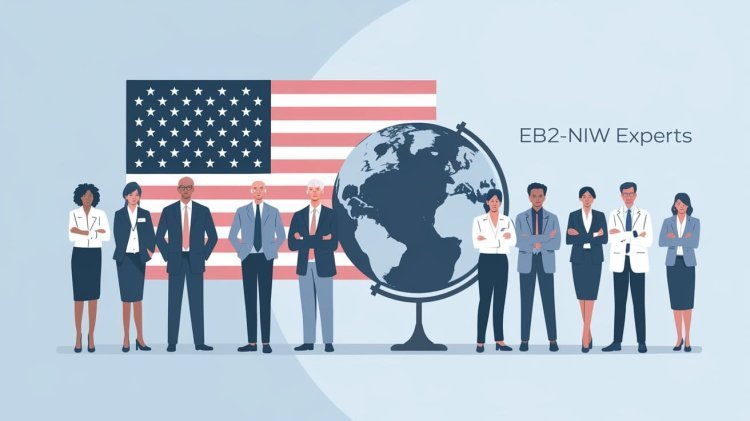EB-2 NIW vs. EB-3: Choosing the Best Path to U.S. Permanent Residency
Compare EB-2 NIW and EB-3 visas to find the best path to U.S. permanent residency. Learn about eligibility, benefits, processing times, and key differences.

For professionals with a high level of skill who want to obtain U.S. permanent residency, the National Interest Waiver (NIW) and the EB-3 category of visas are the two most popular choices. Both offer a pathway towards obtaining a Green Card, and they come with their conditions for eligibility, processing time, and benefits. Selecting the appropriate category is based on various factors, including your qualifications, your job offer, and your long-term career goals piece; we'll look at the differences between the two categories, EB-2 NIW vs EB-3, for you to determine the most appropriate route to take for your journey through immigration.
Understanding the EB-2 NIW and EB-3 Categories
What is EB-2 NIW?
The EB-2 is for those who have outstanding degrees or capability in proving how their work contributes to those in the United States. The most significant benefit for the NIW is the ability to apply for the position themselves without requiring an employment sponsorship from the employer or a labour certificate.
Key Requirements for EB-2 NIW:
Advanced degree: This degree is a master's or more or a bachelor's level degree, combined with five years of progressive experience.
Extraordinary Ability: If a candidate does not hold a doctorate, they must demonstrate extraordinary abilities in their chosen field (e.g., science and business or arts).
National Interest Criteria: USCIS applies the Dhanasar framework that requires applicants to demonstrate:
Their work is highly regarded and is of national significance.
They're in a good position to develop their fields.
The waiver of the benefits for labour certification in the U.S.
What is EB-3?
This EB-3 (Employment-Based 3rd Preference) category is for professional workers and highly skilled individuals who do not have a job offer from a U.S. employer. In contrast to EB-2 NIW, it needs employer approval, a labour certificate (PERM procedure) and proof that no U.S. worker is available for the post.
Key Requirements for EB-3:
Professionals: Need to hold a bachelor's or equivalent foreign degree.
Skilled workers: Minimum of two years experience working or learning.
Unskilled workers: jobs that need under two years' training (e.g. farmers, agricultural workers).
Job Description: The U.S. employer must offer the possibility of permanent, full-time, continuous employment.
Labour Certification (PERM): Employer must demonstrate the hiring of a foreign worker won't cause a loss of U.S. workers.
Pros and Cons of EB-2 NIW vs. the EB-3
Advantages of EB-2 NIW
There is no requirement for a job offer: The applicant can submit an application independently without relying on sponsorship from your employer.
Overrides the PERM Process: There is no need to undergo a long labour certification procedure.
Flexible Career: No need to be restricted to one particular company or work position.
Speedier processing (Potentially): Since there is no PERM, the process might be more rapid than the EB-3 based on visa availability.
Disadvantages of EB-2 NIW
Higher Eligibility bar: The applicants have to show notable achievements as well as national significance.
Subjective Exam: USCIS officers have discretion when deciding whether or not your activities benefit the U.S.
The processing time is longer for certain Countries: In countries such as India as well as China waiting for visas EB-2, wait durations can be very long because of the an extremely high demand.
Advantages of EB-3
Easier eligibility: requirements are not as rigorous as those for EB-2 or NIW.
A more predictable process: since employer endorsement and a job offer are both mandatory, the approval process is determined more by market conditions, not by the subjective argument about national interest.
A Pathway for Skilled as well as Unskilled Workers: Contrary to the EB-2 program that offers NIW benefits, EB-3 provides the possibility of employment for people who do not have outstanding degrees or skills.
Disadvantages of EB-3
Requires employer sponsorship: The applicant must receive an employment offer before applying.
PERM Processing Delays: The labour certification process could take between 6 and 12 months, which can delay the application.
Employer dependence: Must you be employed by your employer of choice until you receive the Green Card?
Which Visa Category is Right for You?
Select EB-2 NIW:
Have a degree that is advanced (master's or greater) or demonstrate extraordinary capability.
Your contribution is of national significance (e.g. research or entrepreneurship, technologies and healthcare and more. ).
You would prefer autonomy and don't want to be tethered to an employer.
It is important to stay clear of the long PERM labour certification process.
You should select EB-3 for:
A U.S. employer is willing to support you.
The job you are working on is covered under professional, skilled or untrained worker categories.
It is possible that you don't fulfil the stringent EB-2 NIW eligibility requirements.
It is okay to work as a sponsor until you receive the Green Card.
Final Thoughts
Both the EB-2 NIW and EB-3 are viable routes for U.S. permanent residency, but deciding which one is best depends on your skills, qualifications, circumstances, and long-term plans for your career. If you have a solid record and a national interest, EB-2 NIW offers an alternative that is more flexible and a self-contained route. In contrast, EB-3 is an excellent option for skilled and professional workers with a U.S. employer ready to provide them with a sponsorship.
When deciding on a plan, it's best to talk with an immigration lawyer or specialist to evaluate your credentials and select the right method for submitting the Green Card application. A wise choice could be the key to reaching your U.S. immigration goals efficiently and efficiently.
What's Your Reaction?












